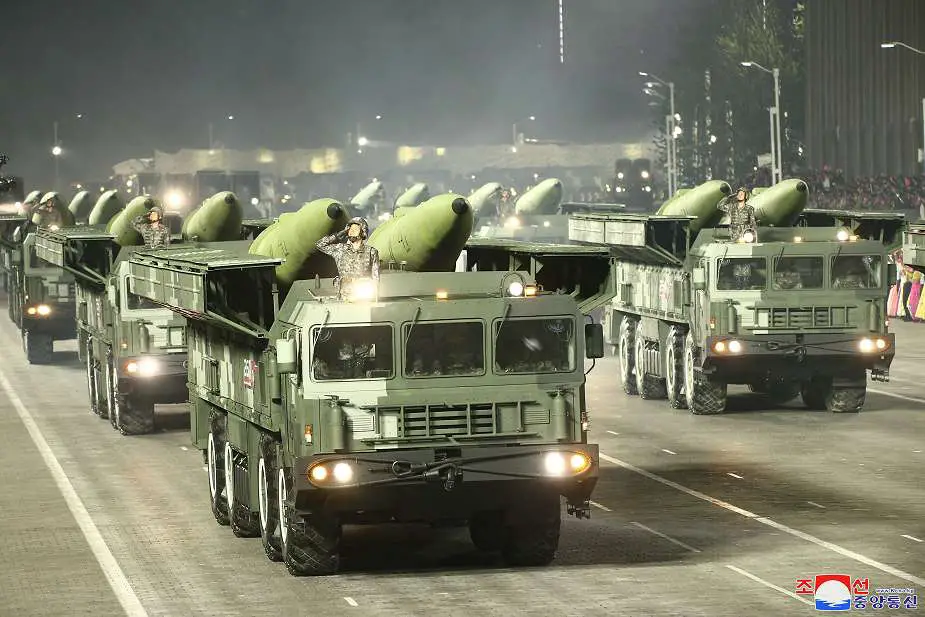Breaking news
US Accuses North Korea of Shipping Arms to Russia Including KN-23 Ballistic Missiles.
The United States Department of Defense (DoD) has reported that North Korea dispatched over 1,000 containers of arms and ammunition including KN-23 tactical ballistic missiles to Russia in October 2023. This development marks a significant escalation in North Korea's involvement in the Ukraine conflict. Photographs released by the U.S. show a large accumulation of these containers at Najin, a North Korean port city near the Russian border. These arms were then reportedly transported across Russia to a location near the Ukrainian frontier.
Follow Army Recognition on Google News at this link

North Korean KN-23 mobile ballistic missile launcher. (Picture source NK News)
This news surfaces amidst doubts about North Korea's military support for Russia. Despite North Korean leader Kim Jong-un's expressed support for Russia's invasion of Ukraine, U.S. officials had, until now, seen no concrete evidence of North Korea's active military assistance to Russia. However, they had cautioned that any such assistance would have serious repercussions for Pyongyang.
In response to these allegations, Kremlin spokesperson Dmitry Peskov strongly denied any receipt of arms from North Korea. On October 17, Peskov refuted the U.S. claims, stating that Washington had failed to provide any substantiating evidence. He asserted that Russia will maintain and strengthen its ties with North Korea despite these accusations.
The defense collaboration between North Korea and Russia has a complex history, shaped by geopolitical shifts and strategic interests. Historically, during the Cold War, the Soviet Union was a key ally and arms supplier to North Korea, providing substantial military aid and expertise. This relationship contributed significantly to the development of North Korea's military capabilities. However, with the collapse of the Soviet Union, this alliance weakened, and Russia, under a new political climate, distanced itself from North Korea, aligning more with Western interests. Despite this, there have been occasional interactions and agreements, primarily focused on arms sales and military technology exchanges, reflecting a relationship-driven more by convenience and mutual benefits rather than ideological alignment.
In recent years, the nature of the defense collaboration between North Korea and Russia has been the subject of speculation and controversy, especially in the context of international sanctions and diplomatic isolation faced by both countries. Allegations, such as those of North Korea supplying arms to Russia amid the conflict in Ukraine, suggest a potential revival or intensification of military cooperation. However, the exact extent and nature of this collaboration remain opaque, often clouded by geopolitical rhetoric and denials from both parties. Russia's strategic interest in maintaining a relationship with North Korea is likely influenced by its desire to exert influence in East Asia and counterbalance U.S. presence, while North Korea seeks to bolster its defense capabilities and gain political leverage.
Further intensifying the situation, sources have revealed that among the weapons shipped to Russia is the KN-23, a North Korean short-range ballistic missile, which closely resembles the Russian Iskander-M missile. The Iskander-M has been extensively utilized by Russian forces in the ongoing conflict in Ukraine, raising concerns about the potential impact of North Korea's involvement in the war.
The KN-23 is a North Korean short-range ballistic missile, notable for its distinct features and capabilities. It is modeled after the Russian Iskander missile system, with a solid-fuel propulsion system that enables quicker launch preparation compared to liquid-fueled missiles. The missile is capable of carrying a variety of warheads, including conventional and potentially nuclear warheads, making it a versatile weapon in North Korea's arsenal. Its design incorporates a quasi-ballistic trajectory, which allows the missile to maneuver during flight, making it more difficult to intercept with traditional missile defense systems.
One of the key characteristics of the KN-23 is its range and accuracy. It has an estimated range of approximately 400 to 600 kilometers, which places a significant portion of the Korean Peninsula and parts of Japan within its reach. The missile's guidance system is advanced, providing improved accuracy compared to older North Korean ballistic missiles. This enhanced precision, combined with its maneuverability and relatively short flight times, poses a considerable challenge to regional missile defense systems, increasing the strategic threat posed by North Korea in its regional security context.
Defense News November 2023




























